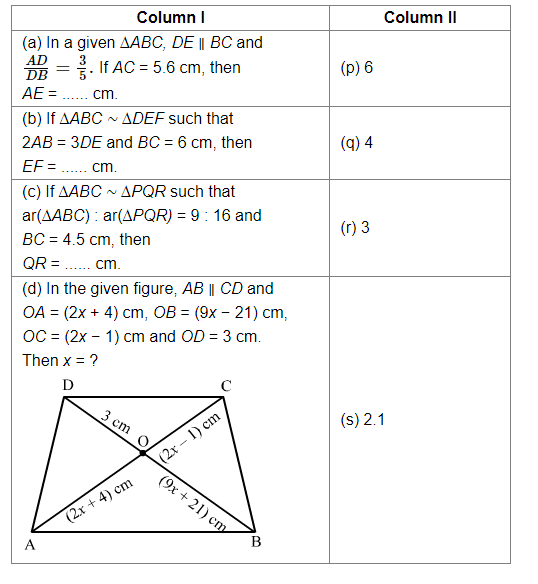Match the following columns:

(a) - (s)
Let AE be x.
Therefore, $\mathrm{EC}=5.6-x$
It is given that $\mathrm{DE} \| \mathrm{BC}$.
Therefore, by B.P.T., we get:
$\frac{A D}{D B}=\frac{A E}{E C}$
$\Rightarrow \frac{3}{5}=\frac{x}{5.6-x}$
$\Rightarrow 3(5.6-x)=5 x$
$\Rightarrow 16.8-3 x=5 x$
$\Rightarrow 8 x=16.8$
$\Rightarrow x=2.1 \mathrm{~cm}$
(b) - (q)
$\because \triangle A B C \sim \triangle D E F$
$\therefore \frac{A B}{D E}=\frac{B C}{E F}$
$\Rightarrow \frac{3}{2}=\frac{6}{E F}$
$E F=\frac{6 \times 2}{3}=4 \mathrm{~cm}$
(c) - (p)
$\because \triangle A B C \sim \triangle P Q R$
$\therefore \frac{a r(\triangle A B C)}{a r(\triangle P Q R)}=\frac{B C^{2}}{Q R^{2}}$
$\Rightarrow \frac{9}{16}=\frac{4.5^{2}}{Q R^{2}} \Rightarrow Q R=\sqrt{\frac{4.5 \times 4.5 \times 16}{9}}=\frac{4.5 \times 4}{3}=6 \mathrm{~cm}$
(d) - (r)
$\because A B \| C D$
$\therefore \frac{O A}{O B}=\frac{O C}{O D}$ (Thales' theorem)
$\Rightarrow \frac{2 x+4}{9 x-21}=\frac{2 x-1}{3}$
$\Rightarrow 3(2 x+4)=(2 x-1)(9 x-21)$
$\Rightarrow 6 x+12=18 x^{2}-42 x-9 x+21$
$\Rightarrow 18 x^{2}-57 x+9=0$
$\Rightarrow 6 x^{2}-19 x+3=0$
$\Rightarrow 6 x^{2}-18 x-x+3=0$
$\Rightarrow(6 x-1)(x-3)=0$
$\Rightarrow x=3$ or $x=-\frac{1}{6}$
But $x=-\frac{1}{6}$ makes $(2 x-1)<0$, which is not possible.
Therefore, $x=3$
